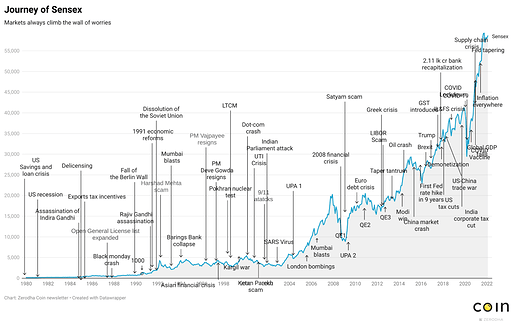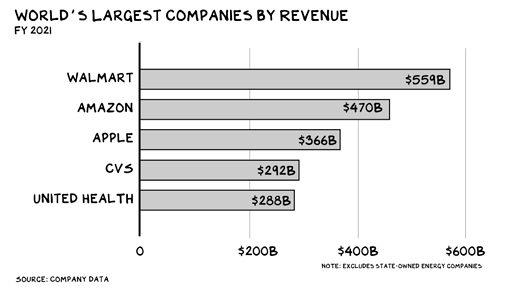How to survive a bear market?
Stock markets have been on a spectacular upward trajectory from the lows of March 2020 to hitting record new all-time highs in 2021. Meanwhile, 2022 so far has been rough sailing. Rising inflation, central banks around the world tightening monetary policies, and geopolitical tensions have markets around the world on a correction course.
All is well and good when everything is going exactly the way we want. But the moment things start to go slightly awry there is panic. That’s human nature. And this fear is exponential when money is on the line. In times like this people often tend to panic and do irrational things that do more damage than good.
We are wildly optimistic about ourselves and underestimate the odds of bad things happening. But we tend to be quite pessimistic about the world in general. This explains why bearish news can travel around the world while bullish news is still putting on its shoes.
We’ve kept seeing events that could trigger the next big crash every few years, but despite that, the Sensex kept chugging along. Investing requires a fair bit of optimism.
A brilliant write-up by @Bhuvan on how to survive in these times.
When the ARKK is full
Investors always keep getting attracted to what goes up because no one wants to miss out on the next big thing. This cycle has played out for centuries in markets and it is still happening right now. But the thing is most money floods into assets at inopportune times, when the prices have peaked. Then the narrative shifts and everyone who bought the top is left holding the bag.
We tend to make proactive moves at reactive times, to our own detriment.
Price always drives the narrative, at first because good stories are powerful tailwinds until they aren’t. Oil was dead until it wasn’t. EV stocks could only go up until they didn’t. The time to take caution is when a narrative goes mainstream, but we rarely do that. If we did, that narrative wouldn’t be mainstream in the first place.
If everyone knew to buy the dip, there would be no dip. If everyone knew a stock had topped, they would sell and it would never reach that peak. Investing sounds easy in theory, but it is so damn hard in real-time. Stocks make wild moves when stories overpower fundamentals, but the stories are so good that we never notice until after the fact.
Now You Get It
You can spend all the time learning about something, reading all the books or watching all the videos. You think you know how it’ll feel. Then you experience it firsthand and you realize, Ah, OK. It’s more complicated than you thought.
Textbooks and classrooms can’t teach what genuine fear, adrenaline, and uncertainty feel like. So you think you understand how a field works until you experience a new part of it firsthand. Then you see it through a completely different lens.
All past declines look like opportunities and all future declines look like risks. It’s one of the great ironies in investing. But it happens for a reason: When studying history you know how the story ends, and it’s impossible to un-remember what you know today when thinking about the past. So it’s hard to imagine alternative outcomes when looking backward, but when looking ahead you know there are a thousand different paths we could end up on.
Buffett’s $152B Apple bet
Warren Buffett hasn’t been the biggest advocate of Tech. At Berkshire’s annual general meeting in 2012, he said he’d never buy Apple or Google because he “just didn’t know how to value them.”
Berkshire eventually did start investing in Apple in 2016. Investing $36B into the company by the end of 2018. Since then, Apple’s value has 4x’d from ~$700b to $2.8T and Berkshire’s 5.4% stake in the iPhone maker is worth $152B for an unrealized gain of $116B. What’s more, Berkshire enjoys $775m from Apple in annual dividends.
An explainer on;
- Why Buffett shunned tech
- The case for Apple
- Ranking the best tech investments
More on Apple, at the start of the year it became the first company in the world to hit $3T market cap. But as Scott Galloway puts it; “Round numbers have no inherent meaning — they’re a consequence of 10 fingers. But they provide a benchmark, a way to focus our observations. While market cap can fluctuate 20%+ in several minutes, revenue is closer to the epicenter of stakeholder value, because it benchmarks actual commerce.”
Let’s set a more audacious goal: $1 trillion in revenue . We’re still a few years away — the largest company by revenue today, Walmart, brought in $559 billion last fiscal year.
So can Apple do $1 trillion in revenue? Or rather, how can it achieve $1 trillion in revenue.
The professor who beat the roulette table
How a renowned researcher beat the odds, stumped casino owners around the world, and walked away with a fortune.
What to listen:
So what have you been reading, listening, watching to? Share below ![]()

